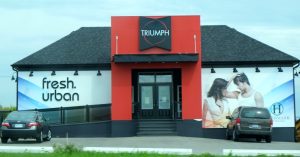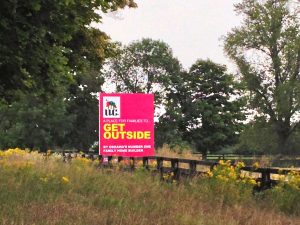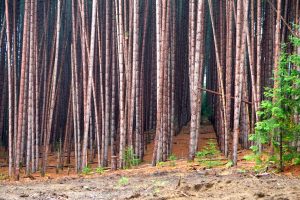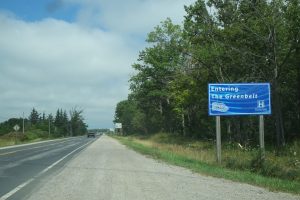By Roger Keil
The book The Natural City, edited by Ingrid Leman Stefanovic and Stephen Bede Scharper, provides a wonderful cross-section of state of the art thinking on urban-nature relationships in the broadest sense. The subtitle of the book suggests a particular interest in the “built environment” but even the casual reader will notice that the book offers far more than that: an engagement with ecologies of the mind and spirituality on one hand and the political economies and spatialities populated by human and non-human nature on the other. The city, of course, is never just built environment, and what’s built never contains the city. That might be a good starting point to think about their relationship with nature, environment, ecology.
There are a number of contributions to The Natural City that take on the question on the complexity of the societal relationships with nature directly. I like, for example, how the ones by Hilary Cunningham and Shubhra Gururani, point to the global scale and particularly the Global South as the true and important terrain on which we need to discuss how we can have natural cities, if we can have them at all.
Because, of course, the whole debate on the natural city is usually mired by the tendency to overlook the real existing relationships of nature-society interactions in urban contexts in favour of an idealized, imagined and normative notion of what makes a city natural, sustainable, or to use the mot du jour, resilient!
We just have to remind ourselves, because we already know, that cities are not unnatural, that there is no clear dividing line between what is called city and what is called nature. In my view, and that view is informed by a body of work under the banner of “urban political ecology,” we have dissolved the permanences and certainties suggested by the notions “nature” and “city” into a host of changing relationships between processes that can be condensed, for conceptual and analytical reasons, into urbanization and the production of space on one end and the production and reproduction of bio-physical conditions on the other. We have come to call the material streams that tie these two processes together, metabolisms. Such metabolisms, exchanges of stuff and energy that fuel the cyborg we call city are not natural occurrences but they are, for better or for worse, regulated, financed, enabled by human action. In cities such as Toronto, the metabolisms that feed urban life are spread far and wide around the globe. We live, as Tim Luke has noted, in a global city system with a lower case ‘g: all cities all around the globe are part of a network that depends on distanced relationships. He contends that “it is no longer clear that “Nature” is what surrounds humans in cities. Instead one must ask if the world-wide webs of energy, information, material and population exchange flowing between cities around the world now are infiltrating Nature so completely that this new artificial ecology will undercut entirely the survival of human and nonhuman beings?” (Luke 2006: 276). Yet while sounding the alarms, Luke also opens a window towards political practice when he says: “as a planetary system of material production and consumption, these built environments constitute much of the world-wide webs of logistical flows which swamp over the conventional boundaries between the human and the natural with a new biopolitics of urbanism” (Ibid. 277). Herein lies an incredible chance to think the city, every city, and indeed Toronto differently. We are, in fact, part of a larger set of urban political ecology relationships that are transnational which makes each local action ethically and materially part of a larger field of meaning and significance. This will allow us to shed what Angelo and Wachsmuth have called our “methodological city-ism” and engage a truly urban agenda that spans the width and length of those metabolic relationships that constitute what is urban in Toronto and elsewhere.
Coming at this from the side of the city, and following the proposition by Henri Lefebvre , we can state, at the outset, that we now live in an urban society. In urban society, cities as concepts disappear. When all is urban, what can be the city? And, yet, as David Wachsmuth has taught us, beyond its conceptual death, we should keep the city alive “as a category of practice: a representation of urbanization processes that exceed it” (Wachsmuth 2014: 354). A representation. In this suggestion lies an important truth. While the city is increasingly a fictional object in an urbanized world, it is also the place and the terrain where we live, work and play and where decisions are made. In practice, then, the city is the political terrain for an ecology of justice. But this ecology is bigger than the built environment that we normally call the city, and definitely larger than the specific inner city environments that mainstream urbanists affectionately call the city.
Globally, 50 percent of the world’s population are statistically urban now, but more live urbanized lives. In Canada, 80 percent are urban but probably even more are urbanized in terms of the connectivities of their local life worlds. Even those that are only marginally urbanized in the classical sense of inhabiting a dense, contiguous urban morphology, are now under a deep and inescapable urban spell. And the so-called ‘countryside’ from where many of them come is not “Nature” in the classical sense either but object of land grabs by multinational corporation in the agribusiness or states that are intent on widening their land mass even if it is on another continent, as it seems to be the practice of India and China in Africa.
We continue to feed ourselves fictional images and accounts of nature and the city, and while critical of the dichotomy, I have contributed to its proliferation myself: After all, Nature and the City is the title of a book I co-authored with Gene Desfor which is, I would think, more complex than its cover might suggest, but nonetheless submits to the difficulty of finding a language beyond the divide. The invention, maintenance and promulgation of this fiction, even if unintended, continues to create conceptual and real boundaries between fetishes such as “nature” and “the city” where we should rather talk about urbanization and metabolisms.
The fictions, of course, help to keep us sane. We all love to see the signs “You are entering the Greenbelt” as we drive north or west out of the city. Being able to name a thing or area “city” and to counterpose it to another thing or area called “nature” is soothing as it gives us options. Among them is to alternate between the two of them by transgressing their geographical boundaries.
Ironically, of course, -- and this is clear to me personally as a long time and passionate supporter of the greenbelt idea in general and this greenbelt in particular -- nothing changes when we cross the divide: we are still in our car as we cross the greenbelt, and the industrial agriculture and golf courses we pass are not really all green. The development industry keeps talking up the metaphor of the belt itself as they use it to sell their faulty and dangerous notion that the greenbelt is pulled too tightly around the built up urban area and suffocates the housing market. They insinuate that the greenbelt is too green and large and too tight a restraint around developable land. This land, of course, belongs to the developers and they stir up a moral panic around the issue to whip prospective customers into a panic.
As Daniel Aldana Cohen has reminded us, the availability of greenbelts and similar escape routes has encouraged yet another fiction, the fable of the dense city and the pedestrianized “flat white economy” : “Living in a dense city doesn’t guarantee a carbon-free lunch. If you’re working-class and live in a public housing tower in Manhattan’s Lower East Side, your carbon footprint is pretty low. But if you’re a prosperous professional living in a modestly sized apartment in Manhattan’s Upper East Side, you’re part of the problem. You likely don’t drive much and you might live a little lighter on the earth than your McMansion-dwelling in-laws, but you probably spend utility and gas savings on a second home, extra imports produced elsewhere, carbon-rich vacations to Aspen and Aruba, or all of the above. Money gets spent, and spending in a fossil-fuel-powered economy exacerbates climate change. The richer you are, the worse you probably are for the atmosphere.” (2014: 152).
We, and here I mean the middle class Toronto urbanists who are driving the nature-environment discourse in particular, need to give up some of these fictions in order to be effective in operating in the city as a category of practice. We need to perhaps do less ritualistic reaffirmation of what we agree on easily: that we all love transit, walkability, cyclepaths, affordable housing, conservation, public water and waste diversion. Those are givens. We need to dig deeper. We have to embrace the complex contradictions of the entire urban region and live with them, change them, defy them, what ever is necessary at any given point. In order to do so, it will be necessary to abandon any localist notion of Toronto. We must at all times acknowledge that we don’t just live in a city but on an urban planet; and when we speak from the perspective of the inner city, as we urbanists are used to, we must remember that the imploding core of our city is serviced, mobilized, fed, provisioned and uncluttered by the surrounding sprawling suburban region and the entire planet that we tend to ignore at best and despise at worst.
Non-linked references:
Luke, Timothy W., 2006. Global Cities vs. “Global Cities”: Rethinking Contemporary Urbanism as Political Ecology, In The Global Cities Reader, Ed. Neil Brenner and Roger Keil. London: Routledge. 275-281. Reprinted from Studies in Political Economy, 71 (2003), 11-22.
Wachsmuth, David, 2014. City as Ideology, In Implosions / Explosions: Towards a Study of Planetary Urbanization, Ed. Neil Brenner. Berlin, Jovis: 353-71.
Acknowledgement:
This is the edited version of my remarks at the panel Toronto and the Natural City: Facing our Ecological Future that took place on Monday, March 2, 2015 at the University of Toronto’s Centre for Ethics in conjunction with the School of the Environment. I thank the organizers, Simone Chambers and Stephen Scharper who invited me to speak and my fellow panellists David Miller, Pamela Robinson, Olivia Chow and Stephen Bede Scharper for their inspiration.



